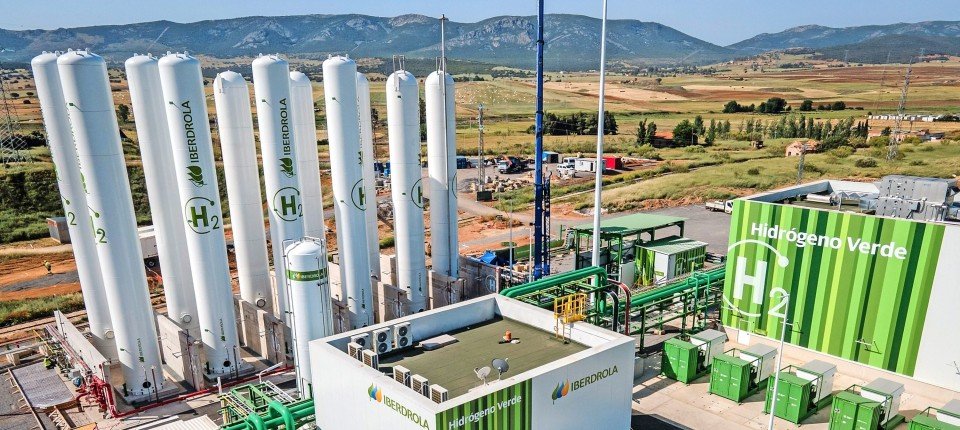Von Hans-CHRISTIAN RÖSSLE / faz.net
Spain wants to become the “hub of the green hydrogen industry in Europe” – and thus replace Russian natural gas. The first factory will soon start operations in the small Castilian town of Puertollano.
In the hot heart of Castilla-La Mancha, the sun is harvested. On the hillside along the road to Puertollano, the solar fields continue to grow. The small town used to live from coal mining. An old winding tower in the center still reminds us of this. After the mines closed, many of the miners went to work in the huge refinery with its countless vents. Today, their sons are driving forward the energy revolution: Spain wants to become a major European power for green hydrogen, and the former mining town with a good 40,000 inhabitants wants to become the capital.
The photovoltaic plants on the outskirts of the city supply the electricity to make Spain the “hub of the green hydrogen industry in Europe,” as Prime Minister Pedro Sánchez puts it. Puertollano is furthest along this path. Europe’s largest green hydrogen factory is located in the industrial area on the outskirts of the city. In May, King Felipe came to the ceremonial opening of the plant, which was built by the energy company Iberdrola. New projects are being unveiled all over the world these days, and industrial production will soon begin in southern Castile after trial operations.
- Warning from housing group: Additional costs in the size of one to two fixed rents
- What is the Diderot Effect?
- Watch As The Sun Disintegrates A Comet
By the end of 2030, Spain wants to create the conditions to produce four gigawatts of green hydrogen. That’s what the national strategy envisions. “HyDeal,” a consortium of around 30 Spanish and international companies, is planning plants with a capacity of up to 67 gigawatts. A large part of this is earmarked for export to France and Germany to help replace the last of Russia’s natural gas with hydrogen.
3000 tons of green hydrogen in the first year
But a lot of electricity is needed to produce the climate-neutral energy carrier. Electricity has accounted for around 70 percent of the costs to date. Here, southern countries like Spain have a major locational advantage: there is plenty of sunshine, plus plenty of wind. Around 48 percent of Spain’s electricity already comes from renewable sources, and this figure is set to rise to 74 percent by 2030. At the same time, solar and photovoltaic systems are becoming cheaper and more efficient. The Spanish approval authorities can hardly cope with the flood of applications.
At the edge of the new photovoltaic plant near Puertollano, deer and wild boar can be observed, especially in the morning when it is cooler and the sun has not yet come over the mountain. For the photovoltaic panels, however, daylight is already enough for the first megawatt of electricity. One hundred megawatts is the capacity that Iberdrola has installed on more than 200 hectares. In front of Puertollano, the industrial park can be seen in the distance, into which the green electricity flows via an underground cable almost ten kilometers long.
The halls and tanks of the new hydrogen plant are painted in fresh green and white. It does not need chimneys from which brown smoke rises, as from the fertilizer plant next door. Iberdrola has set up shop right next to “Fertiberia.” The largest manufacturer of artificial fertilizer in Spain will be the most important customer. Fertiberia wants to replace expensive natural gas with green hydrogen as quickly as possible and operate CO2-free. But that will take some time.
Production at the new 20-megawatt plant will start gradually. 3000 tons of green hydrogen are planned for the first year. That’s just one-tenth of the fertilizer plant’s energy needs. But this will already avoid 48,000 tons of CO2 emissions. By 2027, the aim is to produce 40,000 metric tons of green hydrogen every year. The energy group has spent 150 million euros on the project, which will cost a total of 1.8 billion euros.
Ten liters of water for one kilogram of hydrogen
So far, Fertiberia has been using “gray” hydrogen. It is produced from natural gas and is anything but climate-neutral. For every ton of hydrogen, ten tons of carbon dioxide are produced, most of which is blown into the atmosphere. We also speak of gray hydrogen when electricity from fossil fuels and other non-renewable energy sources is used. Refineries and fertilizer manufacturers consume more than three-quarters of the more than 100 million metric tons of hydrogen produced worldwide each year in this way. It is also used in the steel and chemical industries. In Spain alone, 500,000 tons of it are processed each year, according to government figures.
Green hydrogen can not only help to greatly reduce emissions. It can also help make natural gas suppliers like Russia superfluous. In Puertollano, it is produced at Iberdrola in 16 boxes barely larger than a refrigerator. The electrolysers are the heart of the new plant. The electrolysis process sounds simple, has been known for a long time, but has not yet been used on an industrial scale in Europe: To produce green hydrogen, water is placed under green electricity and then splits into hydrogen and oxygen at a membrane.
It’s actually many dozens of membranes stacked on top of each other, called “stacks.” A thick silver hose supplies them from above with mineralized water that has been purified beforehand. From below, black cables feed the electricity. Nothing else is needed so that hydrogen and process water come out at the end, which can be treated and reused. Ten liters of water are needed for one kilogram of hydrogen, which in its pure form is an invisible, odorless and non-toxic gas, but is also highly explosive. When the plant is in regular operation, no one is allowed to stay in the hall. Only through the windows is it possible to look at the 16 electrolysers. In the end, no one will be needed anyway. The plant is controlled remotely by an Iberdrola control center in Castellón on the Mediterranean.
There is already a use for the process water, which has a temperature of up to 50 degrees and is left over. It will soon flow to Puertollano so that the inhabitants can heat with district heating. The hydrogen itself is processed and compressed in further steps. Then it flows into the eleven white high tanks. They guarantee that the fertilizer plant next door always has a supply for two days.
Repsol also conducts research in Puertollano
Carlos Fúnez looks with satisfaction over the area where a handful of colleagues are still at work. “We started planning in the spring of 2020, and a year later we started construction. Now the tests are running, and at the end of the year we can start production,” says the Iberdrola engineer who planned the project in his hometown. The energy company has first got started at its own expense and has not yet received any Spanish or European aid money, according to Iberdrola.
The energy supplier initially wants to use green hydrogen wherever possible, where it can replace gray hydrogen – as in Puertollano, where Carlos Fúnez shows the inconspicuous pipeline that leads from the high tanks directly to the fertilizer factory. Longer transport routes and the construction or retrofitting of pipelines can therefore be dispensed with. Together with the Swedish company H2 Green Steel, Iberdrola wants to produce green hydrogen with a capacity of one gigawatt on the Iberian Peninsula near a steel mill – for around two million tons of almost emission-free steel annually. Both partners plan to spend around 2.3 billion euros on this. Green hydrogen is an alternative in energy-intensive industries that cannot simply switch to electricity from renewable sources.
At Iberdrola’s partner Fertiberia, the gray hydrogen has so far come from the Repsol refinery next door. Repsol is also conducting research in Puertollano and has teamed up with gas grid operator Enagás: both companies are looking for a way to dispense with electrolysis and produce hydrogen directly from solar energy and water. Elsewhere in Spain, companies and researchers have allied in similar ways. Many of them started in Puertollano, as did Carlos Fúnez, who worked there for a long time at the “National Center for Hydrogen.”
The central and regional governments founded it 15 years ago, when the energy carrier was living an exotic niche existence. Now the institute can profit from its preliminary work and is a sought-after partner. In the laboratories, the employees are researching even more powerful membranes, and in the explosion-proof basement, Miguel Ángel Fernández is showing off the first electrolysers – which are huge steel cabinets compared to the compact boxes in the Iberdrola factory.
“The bigger the vehicle, the better”
“The development has exceeded the most optimistic predictions. Spain is now responsible for one in five hydrogen projects in the world. We have been a kind of incubator,” says the director of the center to which many turn: Large corporations like Iberdrola and Spanish citizens like a recent farmer who wants to produce hydrogen on one of his fields with a solar plant and asked where he could then sell it.
“Green hydrogen is still expensive and needs to become more competitive in the long term,” says Miguel Ángel Fernández. That’s why, for now, it’s primarily an alternative for consumers who need a lot of energy and can’t easily switch to electricity, such as heavy industry, ships, trucks and buses. In Barcelona, Iberdrola is setting up a pilot project for city buses powered by green hydrogen. “The bigger the vehicle, the better,” says Miguel Ángel Fernández. The Spanish government’s hydrogen strategy envisions up to 200 public buses in cities, up to 7500 trucks and more than a hundred charging stations, plus two new rail lines.
The green option will become more attractive if the trend of recent months continues. Because of the rise in the price of natural gas, gray hydrogen has become more expensive than ever before. At times, a kilogram cost nine euros. In comparison, green hydrogen is now cheaper – depending on how high the energy costs turn out to be. Luis Merino nevertheless warns against premature hopes and sees the danger of a “hydrogen euphoria” fueled by the media. The investments of the energy companies fighting for EU funding are considerable, but “only in the medium term will green hydrogen play an important role in Spain,” says the editor-in-chief of the trade journal “Energías Renovables.” Above all, he says, it is necessary to plan well now so that the boom does not become an expensive hydrogen bubble that could burst.
Spain’s energy mix
In Spain, wind is the most important source of energy. Last year, wind turbines provided almost a quarter of all electricity. Most wind turbines are located in Castile-León, Galicia and Aragón. Spain occupies a top position in Europe for wind energy. Solar energy, on the other hand, is only slowly catching up. Until the major financial crisis in 2008, Spain was also the international leader in this field. Then there was an initial halt to expansion. At present, Spain has around 15 gigawatts of photovoltaics; by 2030, this figure is set to rise to at least 39 gigawatts. Even the small Netherlands has more today. This year, however, photovoltaics are about to overtake wind power in Spain. Photovoltaics convert solar energy directly into electricity. Solar thermal power first produces hot water. Hydropower also plays a role, although the consequences of climate change are becoming apparent. Under the Franco dictatorship, many reservoirs were built, but their power plants are struggling with lack of rainfall and increasing drought. The heat, little wind and continuous operation of air-conditioning systems meant that Spain imported much more natural gas this year than usual in the summer. Despite a brief increase in recent weeks, Russia has not played a major role as a supplier. Most gas comes by LNG tanker from the U.S. and the Gulf, and through a pipeline from Algeria. Supplies for the winter are secure; there is no debate about extending the operating lives of nuclear power plants. They produce around one-fifth of the electricity and are to be gradually shut down.
source and author of the published article https://www.faz.net/





